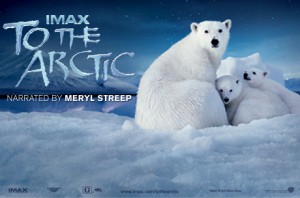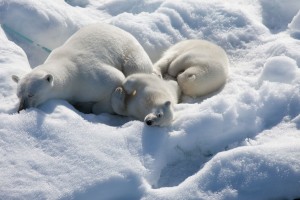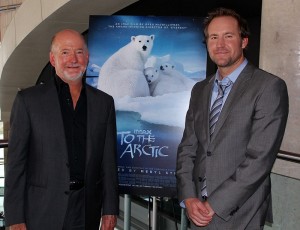 The vast landscape that exists north of the Arctic Circle is a place of extreme conditions and pure, breathtaking vistas that few people will ever get to experience firsthand. The Arctic is also home to a variety of animals that over time have adapted themselves to thrive, and some of these species are found nowhere else on Earth.
The vast landscape that exists north of the Arctic Circle is a place of extreme conditions and pure, breathtaking vistas that few people will ever get to experience firsthand. The Arctic is also home to a variety of animals that over time have adapted themselves to thrive, and some of these species are found nowhere else on Earth.
The breathtaking backdrops of the Arctic would also seem an ideal setting for the production of an IMAX film, yet it’s a place where IMAX cameras have never gone. That is until now.
MacGillivray Freeman Films will release “To the Arctic” on April 20th. The film is the company’s 35th IMAX film which also includes titles such as “Everest” the highest grossing IMAX film ever, and “To Fly” which is selected by the American Library of Congress for inclusion in the National Archives as one of the most important films in the first 100 years of American filmmaking.
The 45 minute documentary film took 5 years to make from concept to final cut and had taken on more than one storyline during its evolution. The end result is a story that raises awareness of the dramatic changes taking place in the Arctic and how these changes, as a result of climate change, are affecting both humans and animals alike.
“It was all mission driven. We’re trying to inspire people and educate people about the arctic” explained Producer Shaun MacGillivray, who I had the chance to interview along with this father and Director Greg MacGillvray last week at the Ontario Science Centre. He further noted that he hoped viewers “come out of the theater and they want to do something. They want to actually do something to help protect this incredible wildlife like our polar bear family.”
The polar bear family he refers to are a mother and two cubs that the crew happened to discover during their 7th and final visit to the Arctic for the film. While To the Arctic depicts the plight of various animal species such as caribou, walrus’ and sea birds, it’s the storyline of the mother struggling against both predators and a changing climate, while protecting her cubs that forms the most endearing component of the film.
“We were extremely fortunate. In the final month of our seven-location shoot, we were privileged to be given our central characters” say Director Greg MacGillivary. “Never before had filmmakers tracked a polar bear family at such close range, 24 hours a day, for nearly a week”. He noted to me that prior to this last visit, the film had essentially been edited but given their miraculous good fortune, the entire film was re-cut and re-written.
The film offers viewers some tremendous cinematography thanks to the utilization of some very unique cameras, including ones that were disguised to look like pieces of ice, or even a round ball that the bears could interact with. Some remarkable underwater camerawork adds a great deal to the story as well. To the Arctic also received some heavy Hollywood Star Power given that the film was narrated by Oscar Winner Merryl Streep. Also in the film were 3 songs from noted envrionmentalist Paul McCartney.
 While I was continually astouded by the breathtaking scenery and images portrayed in the film, I also found myself struggling to determine if this was more of a story about climate change or one relating to more humanistic components of family, love and hope. The environmentalist in me was expecting to see a more poignent example of cause and effect; where the link between the use of fossil fuels and the realities of our arctic were more vividly aligned. While this wasn’t the case, I did find that the parent in me resonated with the struggles of the mother bear as she proved during the film that she would do anything, including possibly laying down her life to protect her offspring.
While I was continually astouded by the breathtaking scenery and images portrayed in the film, I also found myself struggling to determine if this was more of a story about climate change or one relating to more humanistic components of family, love and hope. The environmentalist in me was expecting to see a more poignent example of cause and effect; where the link between the use of fossil fuels and the realities of our arctic were more vividly aligned. While this wasn’t the case, I did find that the parent in me resonated with the struggles of the mother bear as she proved during the film that she would do anything, including possibly laying down her life to protect her offspring.
When I asked Shaun MacGillivary if he saw himself as an activist, he offered “I wouldn’t call us activists, but we are on a mission”. To that extent I suppose that if the mission is to incite an emotional response, whether it be anger, frustration or empathy, and from that to inspire some form of action, than this film has managed to achieve that mission with great effectiveness.
To The Arctic can be seen at IMAX and IMAX 3D theatres across North America beginning April 20th for an extended run. In Toronto, To The Arctic can be seen at the Shoppers Drug Mart Omnimax Theatre, located at the Ontario Science Centre.
More information about To The Arctic can be found on the MacGillivary Freeman Films website.


Leave a Reply